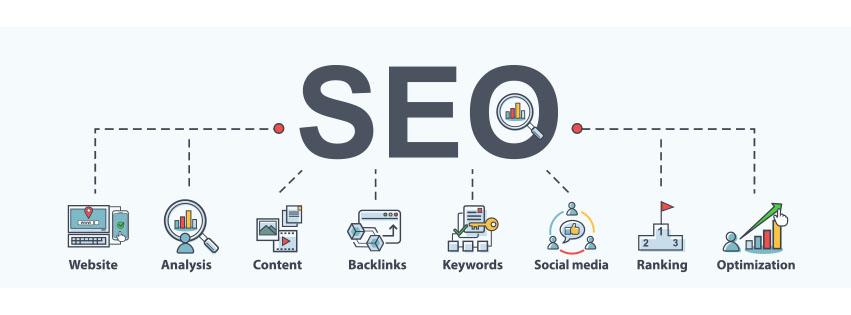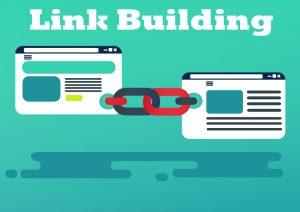SEO Guide: What is SEO and why should my company use it? Learn more below in the only beginner’s SEO guide you’ll ever need.

It’s no secret that more and more people are searching for products and services online. What’s also no secret is that if you’re not on page one of search result pages, you may never get seen.
By starting with the simplest steps and working up, you lay a great foundation for taking a more creative approach to the in-depth tactics. In this SEO starter guide, we will cover what we believe to be the essential actions to begin your SEO journey.
- Does My Company Need SEO?
- What is SEO?
- Keyword Research & Audience Targeting
- SEO Copywriting
- On-Page Optimization
- Site Structure & UX
- Link Building
- Tracking & Measuring
- Executive Summary
Does My Company Need SEO?
According to a study by InFront Webworks, the first page of a Google Search Result receives 95% of the traffic! You might have the best product since ShamWow, but the bottom line is if people don’t know about it, they can’t buy it.

What is SEO?
At its core, search engine optimization (SEO) is a form of digital marketing. It is the practice of strategically building your website in order to naturally rank higher in search results. The goal is simple – to drive more traffic and sales. Unfortunately, that is about the only thing that’s simple about SEO.
You know how things work on the internet. One day it seems the entire world is focused on a nation-wide scandal, the next day you get the same dog video sent to you half a dozen times. The same goes for SEO. You must keep track of emerging trends, changes in how search engines rank pages, technical advancements in the industry and how your audience is reacting.
It sounds like a lot to take in. While there’s certainly a lot of strategies and information to grasp, it helps to keep a simple mentality when looking at SEO. Everything you do related to SEO has the same goals as any other aspect of your business:
- Generate Sales
- Serve Your Audience
- Build Relationships
- Increase Brand Reputation
Google and other search engines don’t play favorites. They are going to place the most relevant and informative websites in front of users. That’s what their reputation depends on.
Whatever your industry, your goal is to be the most informative and trustworthy source for your audience. That’s what leads to traffic, sales and repeat customers, and this leads to a higher ranking in search results. We call that a win-win.
SEO Overview
Books could be (and many have been) written about all the SEO techniques and strategies available to you. However, it’s much better to start from the ground up. We cover the really technical SEO practices in other articles.
In this SEO tutorial, we’ll start with the simpler aspects of SEO and move our way to the more advanced SEO tactics such as backlinking. We cover the really technical SEO mechanics in other articles.
Let’s get started!
Keyword Research & Audience Targeting
If you have researched SEO at all, I am sure you have seen the term “keyword” thrown around a lot. The reason is simple: keywords are the foundation of search engines. If your content doesn’t have the words that people are searching for, you’re not going to show up on the search results.
Sounds crazy, right? You can be one of the leading experts in astronautical engineering and know all the ins and outs of the industry, but the public can’t spell astronautical and will likely search for “rocket science”. You have to be found by how they talk and search, not how you talk.
Keyword research tools allow you to study what your target audience is searching for and what answers they need. If you’re able to supply those answers, Google will take notice and start to deem your website as trustworthy and informative.
You can’t answer the audience’s questions if you don’t know what they’re searching for.
The Basics of Keyword Research
The good news is that there are plenty of keyword search tools available to help. Platforms like SEMrush, Ahrefs, Soovle and even the Google Search Console can give you great insights into what terms and phrases people are searching for.

There are two main things to look for when performing keyword research with any of the tools above: search volume and competition. Search volume tells you how many people have searched for that term. Competition tells you how difficult it is to rank highly for that term.
Search volume indicates the average amount of times in a month that the term was searched. Competition will most often be shown as a decimal between 0 and 1. A search term with a competition of 0.95 is going to be extremely difficult to get to page one for, while a term with a competition of .38 will be much more achievable.
Look for keywords with a high search volume and competition around 0.60 or lower. This is what we call a keyword “sweet spot” and is much easier to get to page one for.
Once you have a list of keywords and phrases you want to target, you start incorporating them into your content and providing valuable insight into those topics. When Google bots crawl through your website’s pages, they will see that you are providing useful information on relevant search terms, or keywords.
More Advanced Keyword Techniques
Keyword Abuse: Just because you have the insight of what your audience is searching for, you don’t want to start stuffing those keywords everywhere on your site. For one, Google becomes more and more advanced every year and they can detect when a website isn’t authentic.
Landing Pages: Don’t just start dumping every keyword related to your industry on every page of your website. Google won’t know which page is relevant to which search query, and this is known as “keyword cannibalization”.
For example, if you own a property restoration company, the phrase “water damage” is certainly relevant to your industry. However, using that keyword on your fire damage page is going to confuse Google bots and take away authority from both pages.
So, when constructing pages and placing keywords, keep in mind each page should target a different core keyword with a collection of related keywords sprinkled in.
We are moving onto our next SEO practice, but trust us, this is not the last time you are going to hear about keywords.
SEO Copywriting
Once you have completed your keyword and audience research, you can begin the writing process! Great writing is just as important as the right keywords.
Just because your content will be full of popular and relevant search terms does not mean it will jump to the top of a search result.
More importantly, if a potential customer comes to your site and finds a block of text that keeps repeating the same words, they will likely move on to the next prospect.
We’re not saying that you have to produce Pulitzer-worthy content, but you need to be thoughtful of your audience and their time. Ranking will come naturally if your website content is of high quality.

Depending on the writing experience your team has, this aspect of SEO could be the easiest or most difficult to tackle. However, no matter what the level of expertise is, SEO copywriting basics begin with these three simple steps:
1. Preparation:
This is where you will conduct your keyword research. It’s also important to determine the purpose of this specific page or blog and create a quick outline. Jumping right into the writing process will end up costing you time, energy and sanity.
2. Writing:
Now the fun part! Even the most experienced writers have trouble coming up with words sometimes. The key is to get the ball rolling, so just start writing.
Most often, the first and last paragraph can be difficult to come up with so don’t be afraid to skip those at the beginning. They will be much easier to write once the foundation of your page is there.
Stick to your outline and make the content readable to the average person. Google also tends to punish pages that have a low word count or duplicate content. Be sure your content is comprehensive and unique.
Having high-quality content is the only way to get your audience to engage, interact with and share your content.
3. Editing:
You would be amazed at how many content creators end up posting work that is riddled with typos and errors. Once you have completed the writing process, read your work slowly and out loud. Emphasize each sentence as you’re going through it to make sure nothing is overlooked.
After you feel comfortable with it, give it to someone else for them to review. After spending so much time on a piece of content, it’s likely that you have put up blinders to certain portions of your writing. Getting a pair of fresh eyes helps cover all the bases.
As you will see later in this guide, creating great content can make a lot of other SEO practices easier.

On-Page Optimization
The content that you created in the previous step is just the beginning of on-page optimization in SEO. However, we all know that a website is not as simple as a Word document. Search engines look at every facet and corner of a website to determine its intent and value.
In this section, we will focus on the main factors of a web page that Google uses to index. While the content can stand alone as valuable, it is the sum of all parts that lets Google know yours is the best page to display to users.
Title Tags
These are not the headlines that will appear on your website page. They are the headline that appears on the search engine results page (SERP). Think of title tags as the billboard that viewers will see as they scroll by on search engines. In essence, it’s what Google and other search engines are tagging as the title of your page or blog.
It should be similar to what your actual headline is, but it can be useful to incorporate your brand or local market as well. Title tags should be no more than 70 characters (otherwise it gets cut off) and should definitely include your core keyword for that page (ideally near the beginning of the title).
Meta Description
Where your title tag is the big, eye-catching headline on a billboard, your meta description would be the ad copy written in smaller text underneath. It shows up just below the title tag on search result pages and should summarize a page’s content. Once again, be sure to incorporate your core keyword in the meta description. The meta description length should be 160 characters or less, otherwise, it gets cut off by Google.
A good meta description will include your core keyword, a small taste of what the content is about and a call to action.

Image Alt Text
The alternative text for an image is what would appear on a screen if the image was unable to load for some reason. Every image on your website should have accompanying alt text. It should be a short description of what is in the image. Act like you are describing the image to someone who can’t see.
While it is still useful to use keywords in your alt text, don’t do it if it is not natural. It is better to give an accurate representation of the image rather than keyword stuffing. The absence of meta, alt and title tags will undoubtedly hurt your ranking.
URL Structure
We will discuss URL structure for SEO more in the next section, but it is worth mentioning here. Your URLs should be as short and descriptive as possible. If you own a coffee and donut shop and are creating a page for your award-winning Boston cream donut, your URL for that page should be along the lines of:
yourcompany.com/donuts/boston-cream/
Creating simple URLs with a clear path structure helps both Google and your audience navigate and understand your products or services.
Site Structure

Hold on tight, because things are about to get technical. Site structure involves the architecture and design of your website. This is where having web developers or IT experts will pay huge dividends.
As advanced as some of these search engines are, they are still limited in how they crawl (read) pages on websites. It is your job to make their job easier. After you spent all that time working on the previous items we’ve covered, the last thing you want is search engines not being able to find your prized content.
There are two main reasons to focus on your site’s layout:
- Information Architecture: Making sure the Google bots can find all your content
- Design and UX: Giving users a clean, functional website to navigate through
Let’s start with the first reason.
Information Architecture
Search engine bots are crawling billions of pages every day. If they get to a crossroads on your website and there is no direction on where to go next, they’re not going to sit there and try to figure it out. Most likely, they’re going to turn around and go to the next town (website).
That’s why it is vital that you structure your website in a way that bots can easily navigate through and determine your authority and trustworthiness. Below are some of the key aspects of a solid site structure for SEO.
Page Indexing: Indexing a page is the process of putting all the non-text content of a page into an HTML format. Google bots can’t decipher what the contents of an image or flash file are, and they often get ignored when your site is crawled.
The best way to ensure that Google is not ignoring any of your site’s content is having an XML sitemap. Think of the sitemap as your website’s table of contents. It is an outline of every active page on your site and allows search engines to efficiently crawl your site and find URLs that may be isolated from the rest of the content.
Link Structure: Each page on your website should have a specific purpose, which means each URL should include a core keyword that summarizes the page. Moreover, you need to create a sound structure that allows you to make as many changes to your site without Google getting confused.
A good URL for SEO should always have a funnel system that leads you to the various products and services. However, if two similar products have conflicting URL paths, it will end up hurting your SEO.
For example, if you are a local grocery store creating separate pages for bananas and apples, which URL structure would be better for SEO:
Yourcompany.com/produce/fruits/bananas
OR
Yourcompany.com/apples
By following the first path, you let search engine bots develop an understanding of your website hierarchy.
Navigation: Your homepage is going to be the landing spot for most people coming to your site. Due to this, you want to make sure all your pages are as few clicks away from the homepage as possible. Internal linking is also a key strategy here, which we’ll discuss below.
Design and User Experience

While this does effect SEO, it might help to look at it as more of a sales and branding tactic. You want to make sure that when users get to your site, they stay there. In order to do this, your site needs to be easy to use, professionally designed and accessible. Users shouldn’t have to search through your site to find direct, actionable information regarded to their query (search).
Features such as page speed and mobile design also play a huge role in the user experience. As of 2021, Google has implemented something called Core Web Vitals. These are metrics that Google takes into account when ranking your website on search results pages. These metrics look at loading performance, interactivity and visual stability to determine if your site provides a positive user experience.
Google has also switched to mobile-first indexing. This means that they will only be looking at the mobile version of your site and its authority for ranking. Making sure that you have a mobile-friendly site will only help improve your user experience and how you rank in search results.
Lastly, your site’s content should be interactive and engaging. When people look at a wall of text, they often get intimidated or drawn away. By incorporating plenty of images, infographics, pull quotes, bulleted or numbered lists and videos, you create a better experience for the user.
While all of that is tailored to satisfy the user, that’s not to say it won’t do anything for your SEO. A great UX design will always help boost your SEO. It will decrease your bounce rate – the percentage of people who leave your site after only viewing one page – and that is certainly a ranking factor for Google.
Link Building
Link building is arguably the most difficult and most important SEO practice.

Every page on the internet carries its own authority and rank. That means each specific link carries its own value. Linking to a page on your site (internal) or linking to another website (external) is nothing new. However, now those links pass value from page to page.
For instance, a site like Amazon.com is going to carry a lot of value and authority. If Amazon were to link to one of your product pages, that “link juice” is transferred over and now your product page carriers more authority and a higher ranking. Google takes that as a sign that your site is more trustworthy since a company like Amazon is endorsing you, so to speak.
Link building takes a lot of hard work and creativity. We will go over some of the main link building strategies for both internal and external linking.
Internal Linking
Internal linking is the process of linking to other pages from within your site. You are creating a web of connections and passing authority between pages. This accomplishes two things: it boosts your SEO and it helps users reach more pages on your site (which also boosts your SEO).
For your audience’s benefit, all the pages on your site should be readily accessible from the homepage with very few clicks or scrolls to reach them. It is proven to increase pageviews and increase the time users spend on your site.
The key to internal linking is strategically linking to important pages from your high-performing pages. Think about which pages on your site gain the most traffic. It will almost always be your homepage followed by a few of your popular service or product pages.
Those are the pages on your site that carry the most authority, and therefore can pass off the most authority and value by having internal links pointing to other pages. By linking to recent blogs or specialty services on your homepage and main service pages, you are letting Google know that those blogs are relevant and valuable. By coming from your most authoritative page, the endorsement is much more valuable than it would be coming from a low-performing page.
That’s not to say you shouldn’t have any internal links outside of your top three or four pages. Every page on your site should have a handful of internal links, but your home page is the prime real estate. Think strategically when placing links, and make sure you are still providing relevant information and direction.
External Linking
While external links (backlinks) are more valuable than internal links, they are also much more difficult to achieve. You must convince someone else that your company, service or blog is worthy enough for them to endorse and link to. There are several ways to go about this, some more difficult than others.
For the purpose of this SEO guide, we will break the types of backlinks down into three main categories, starting with the easiest and least valuable.
Self-Created, Non-Editorial Links: These are links that almost anyone can achieve, hence why they are the least valuable in Google’s eyes. They include forum posts, blog comments and user profiles. A small step away from spam, you can actually be penalized for chasing links in this category. It falls under the class of black-hat SEO practices and is looked at as unethical.
Google even created a nofollow tag that often shows up in these linking opportunities. It was created as a way to subdue the “spam linkers” and give websites a way of telling Google they don’t endorse the link. We advise avoiding this category altogether.
Manual Outreach Links: This is a good place to begin if you’re just starting out with link building. These links include directories, business listings and guest blogging. Think about your local chamber of commerce, a local or industry-specific directory, or other companies you have partnered with. These are all places where you can reach out and ask them to link to your site.
Guest posting or blogging is another great opportunity to earn external links. You are an expert in your industry, and you have valuable information to share. Look for a blog or website in your niche and offer to write a free blog post for them. Most will offer to link to your site, although you might have to ask politely during the process.
The thing to remember about backlinking is that it’s a two-way street. No reputable website, especially those that carry a high authority, is going to be handing out links. You need to be able to offer something for their audience so they want to help and link to your site.
Natural Editorial Links: The best kind of links to get, these also require the most creative backlinking strategy. It takes a lot of networking and building great content. The first step is finding the influencers in your industry.
Who is staying ahead of the trends? Who is regularly active on their social media accounts and blog feeds? Whose reputation carries the most weight?
By finding answers to these questions, you’ll be left with a list of valuable sources you can reach out to for links. You can also look at who your competitors are receiving links from and try to piggyback off them.
Remember that link building is a two-way street. You need to be able to offer something to get links from sites with a lot of authority. The best way to do this is by creating the best content in your industry. If you write a blog on how to build a treehouse making sure it is ten times better than anything else on the internet, it will be much easier to convince influencers in your industry to link to it.
Link Building Summary
For someone new to SEO, link building can be overwhelming. It’s a complex practice that takes a lot of fine-tuning to be successful. There are many resources on the internet that are dedicated to link building and backlinks.
It’s not something that every beginner SEO is going to be able to take on. Nevertheless, it is a vital part of SEO and something you need to understand and be aware of. It is proven to be one of the biggest ranking factors that Google looks at.
Tracking and Measuring
One of the best things about SEO is you can see clear and deliverable results. With tools like Google Analytics, SpyFu, SEMrush and more, you are able to closely monitor how much your SEO work is affecting your site’s performance.
There is an endless amount of data that will be available to you, but for beginners, there are three main things you should be tracking.
- Keyword Search Ranking
- Organic Traffic
- Conversions

A keyword ranking tool will tell you where you rank on a search engine results page for a specific keyword in a specific market. So when you perform keyword research and create a page or blog, you can then begin to track those keywords to see if your page starts climbing to the top position.
It is a good indicator of how effective your SEO writing is and how much competition is in front of you. It can also give you insights into which keywords you need to start performing better on. If you’re ranking well for all your services except one, it is probably time to rewrite that page and perform new keyword research.
Organic traffic tells you how many people are coming into your site by searching for relevant terms. In other words, the people who discovered you on a search result without ever knowing you before. Organic traffic is one of the best indicators of how well your SEO is working.
Conversion tracking is important because it’s the reason we all do SEO – to drive more sales. By tracking how many people are completing a purchase, filling out a contact form or subscribing to a blog, you can see a clear ROI.
Executive Summary
Unfortunately, not many people are going to master SEO by reading a beginner’s guide. It takes a lot of trial and error to figure out what works best for your website. However, after reading this you should have a solid foundation of things you can do to start and what you have to keep in mind.
In conclusion:
- You should not write or post anything on your site without conducting thorough keyword research and audience targeting.
- Take writing seriously. Develop a process that allows you to produce consistent, quality content the information your audience is searching for.
- Make sure your on-page elements are properly set up and include keywords (title tags, meta, alt tags, URLs)
- Organize your site structure so search engines can easily crawl through your website without getting lost or confused.
- Create a good user experience by having a professional design and easy-to-use website.
- Strategically link to pages within your site (internal linking).
- Find influencers in your industry and reach out for backlinking opportunities (external linking).
- Track your SEO success by measuring keyword rankings, organic traffic and conversion rates.
Onward & Upward!


